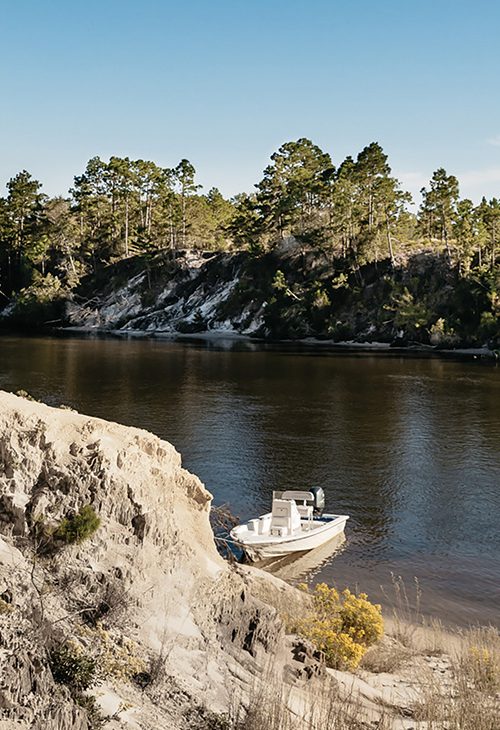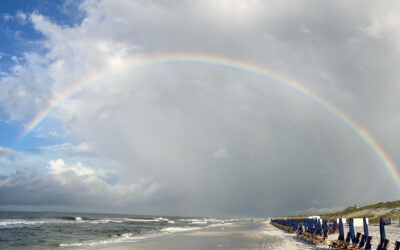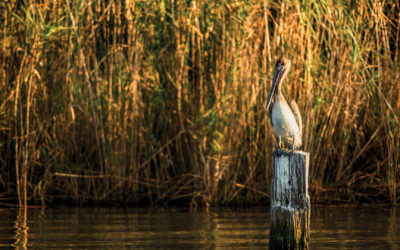waterways of the panhandle
It’s a watery realm few ever see...

^ Spanish moss, a close relative of the pineapple, drifts in the coastal breeze. Both are “air plants,” or epiphytes, that draw moisture from the atmosphere. Various creatures use it as cover to hide from predators and as nesting material.
Join us as we explore the waterways of eastern Choctawhatchee Bay. While in the neighborhood, we wander off on a couple of detours—the first into the spectacular Gulf Intracoastal Waterway, the second up the little-known waters of the Choctawhatchee Watershed.
CHOCTAWHATCHEE WATERSHED
It’s a watery realm few ever see, a largely untouched network of rivers and creeks where little has changed over the decades.
The headwaters of the Choctawhatchee watershed begin in southern Alabama where small streams pick up a cargo of sediment on a journey toward the Gulf of Mexico. They quickly become a lattice of tributaries that slowly swell and as they wind their way southward, ultimately forming a delta in the southern-most reaches.
Near Choctawhatchee Bay, the network of creeks is knitted together by sloughs, ponds and untouched swampland. Here you can find yellow water lilies, pickerelweed, arrow grass, bullrush and even wild rice. The seemingly primordial alligator gar can be seen sunning themselves on the surface of brackish water while below you’ll find entire populations of gamefish, including Southern flounder, striped mullet, sturgeon, tarpon and the occasional bull shark.
The last few miles of the watershed become increasingly influenced by the tide, alternately swelling and draining the swamplands with each cycle. The streams also become brackish, with freshwater species giving way to saltwater species. Finally, the streams and rivers meet the Bay.
v Surrounding forest and a sandy riverbed make the Choctawhatchee watershed a suitable tropical storm and hurricane anchorage. In the distance, a sailing ketch is moored among a stand of pines.
GULF INTRACOASTAL WATERWAY
Work on the Gulf Intracoastal Waterway began in fits and starts in the 1920s. Its purpose was both commercial and military: to create a contiguous stretch of protected waters for shipping along the northern Gulf Coast. When completed, it would extend 1,300 miles from Brownsville, Texas to Carabelle, Florida on Apalachee Bay. But the most challenging and expensive section would be saved for last.
This final section was the 26-mile canal that had to be cut between Choctawhatchee Bay and St. Andrew Bay. Within this stretch was an eight-mile
section that would be, by far, the most difficult of this incredibly challenging cut—an area called “The Little Grand Canyon.” This part of the cut begins just a few miles into the canal from the Choctawhatchee Bay side.
The canal was the last of the Gulf Intracoastal Waterway to be undertaken and wouldn’t be completed until 1938. Today it is open to navigation for commercial traffic—mainly barges—and recreational boats.
v The canal is a key waterway for barge traffic along the Gulf Coast, allowing for the transport of millions of tons of cargo annually. In 1944, at the peak of the Second World War, over 3.5 million tons passed through the canal. Today it also serves as a popular waterway for local fishermen and recreational boaters. Its protected waters, bluffs and sandy bottom make it a suitable “hurricane hole” for vessels during cyclone season.

^ The most challenging stretch of the entire Gulf Intracoastal Waterway—the “Little Grand Canyon”—which marks the highest point in elevation between the bays. The massive volume of sand and clay that had to be dredged and relocated created 40-foot bluffs on either side of the canal. The cut was first opened to navigation in 1938 but was closed for a time due to the erosion of the bluffs that eventually returned much of the sediment to the canal. Today the Little Grand Canyon is a popular stopping point for recreational boaters.
Recent Stories
Explore and discover all of the Emerald coast.
Sandcastle Kids: Healing Hearts
Sandcastle Kids, a South Walton 501c3 nonprofit, carries out their healing mission by providing all-expenses-paid vacations to families experiencing a diagnosis of childhood cancer. As you can imagine, these families undergo tremendous mental, emotional, and financial...
The Secret History of Eastern Choctawhatchee Bay
There’s an odd cluster of pilings on the eastern edge of the Choctawhatchee Bay. Ever noticed them when driving north across the bridge? These aren’t the remains of an ill-fated attempt at a bridge, but are part of a system capable of detecting low-flying aircraft...
Serving in Seaside for 23 Years and Counting
Bartender Mo Mosely has been greeting patrons and slinging drinks at Bud and Alley’s rooftop bar for 23 years (and counting). Back before Scenic 30A was the bustling, year-round destination that it is today, Bud and Alley’s was the only bar on 30A open late into the...



